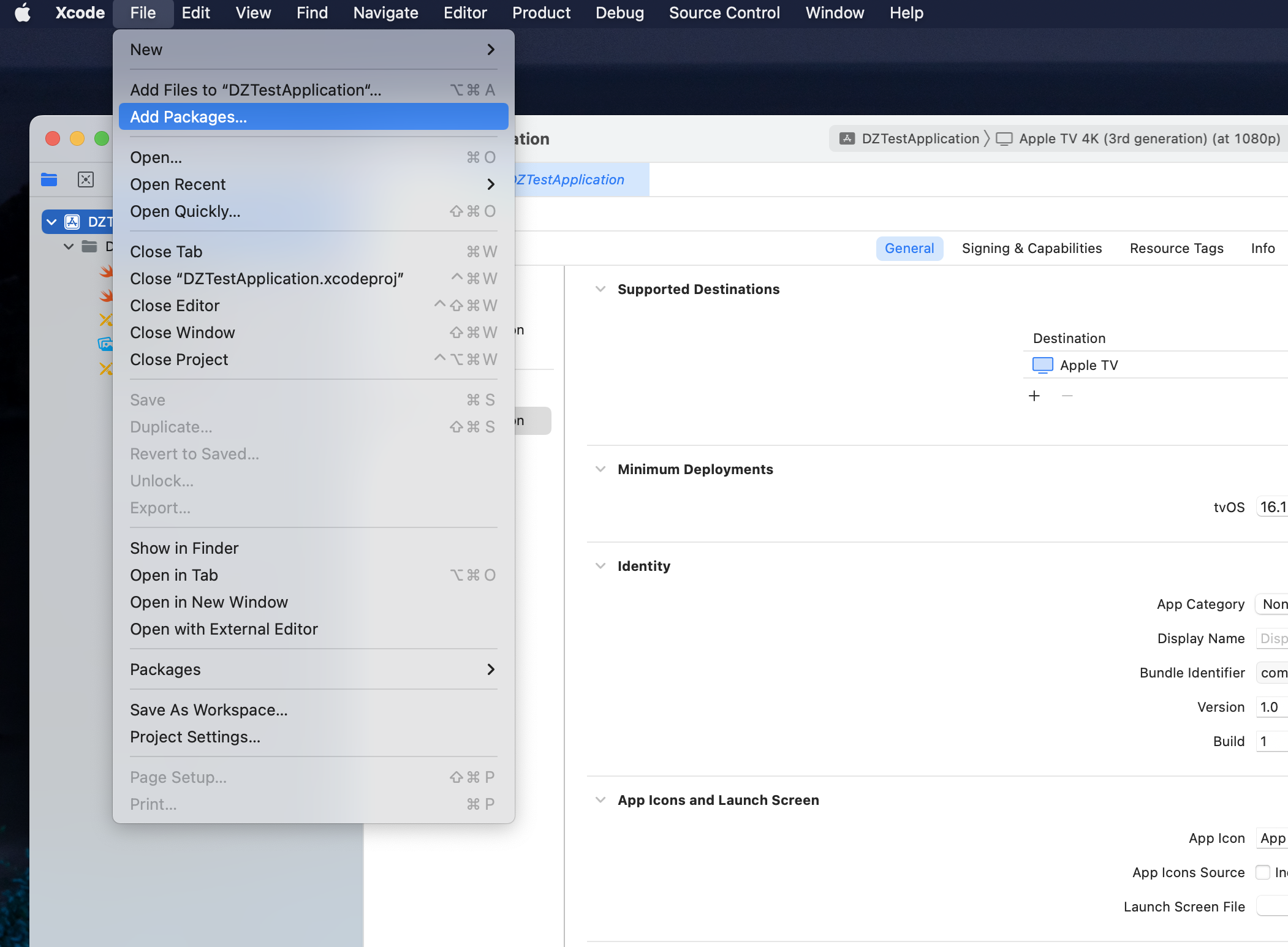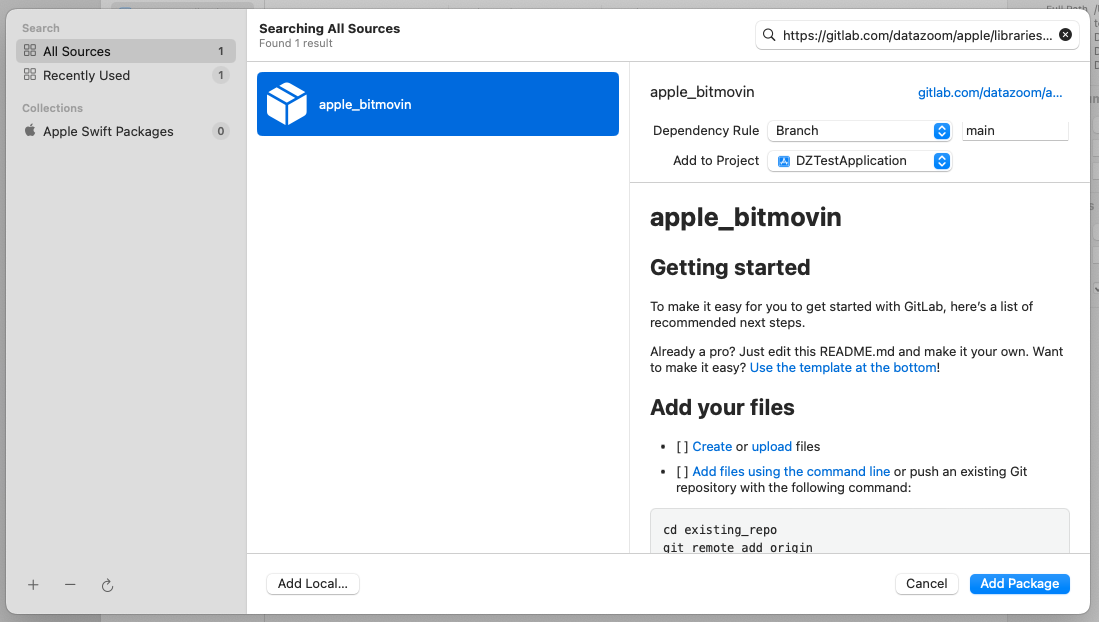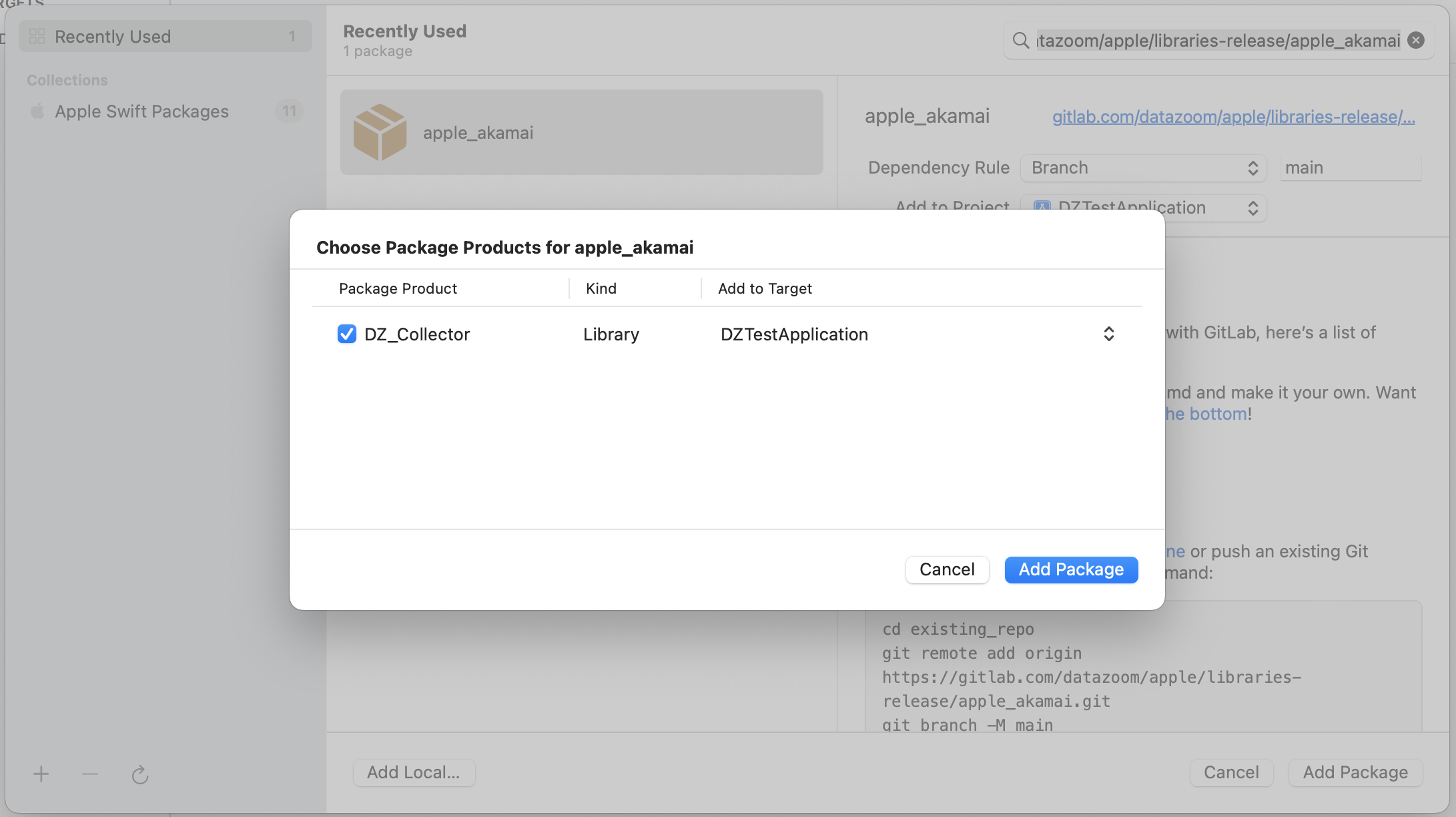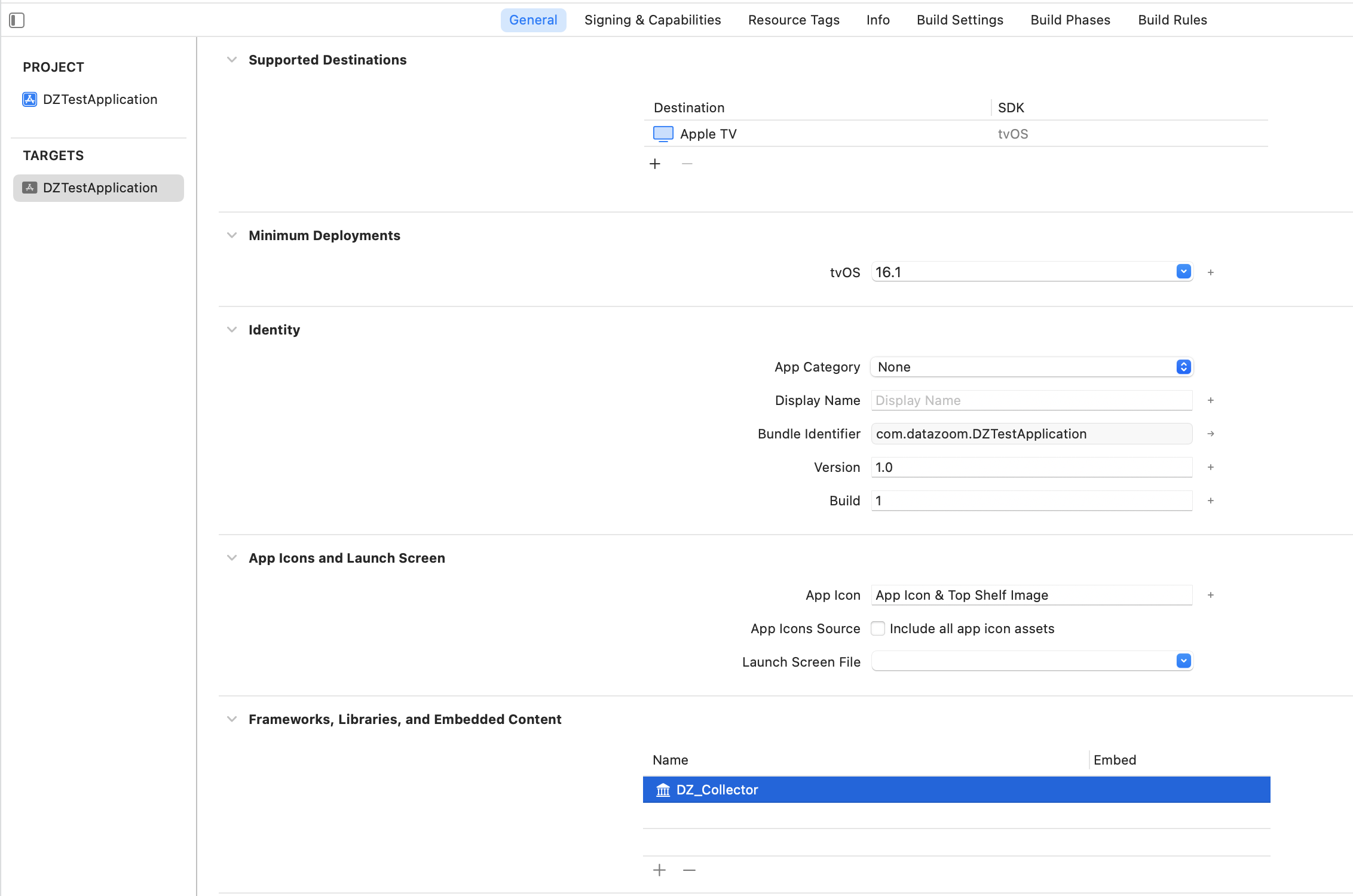Application collectors
Akamai AMP Media Player
Ios / tvos collector
The Akamai amp media player is a configuration option for the Ios / tvos collector by Datazoom that makes the following additional data points automatically collectable in real time.
Data Points
Events
Discrete occurrences driven by user interactions or system actions
Metadata
Attributes
Video
Player
User
Events
Media Request
When media type is 'content', this is triggered when playback is invoked. When the media type is 'ad', this is triggered when VAST request is made.
| Supported Media Types |
Content
|
| Notes |
Identify problems that may be occurring in the video player which prevent successful playback after a user requests playback.
|
Playback Complete
When the video player reaches the end of the currently playing content. The event can be triggered multiple times if the user reaches the end of the currently playing content, scrubs back and then reaches the end of the content again.
| Supported Media Types |
Content
|
Seek End
When a user stops seeking.
| Supported Media Types |
Content
|
| Notes |
This event includes attributes Seek Start Point & Seek End Point to mark the starting & ending points of a seek event.
|
Seek Start
When a user begins seeking.
| Supported Media Types |
Content
|
Metadata
User
Content Session ID
A unique id for the current video playback session.
| Data type |
string
|
| Number Type |
Not set
|
| Required |
true
|
| Permitted Values |
UUID
|
Attributes
Error Code
Error code emitted by the player
| Data type |
string
|
| Number Type |
Not set
|
| Required |
true
|
Player
Player Name
The name of the media player.
| Data type |
string
|
| Number Type |
Not set
|
| Required |
true
|
Streaming Type
Whether the content is Live, VOD or DVR as reported by the media player.
| Data type |
string
|
| Number Type |
Not set
|
| Permitted Values |
value list
|
Video
Title
The title of the content as reported by the media player.
| Data type |
string
|
| Number Type |
Not set
|
Ad frameworks
Player Default Ad Framework
Freewheel Ad Framework
Google IMA Ad Framework
Google IMA DAI Ad Framework
MediaTailor Ad Framework
Yospace Ad Framework
iOS / tvOS version 12.1+ XCode 14.1+ ( Swift 5.7.1+ ) The preferred way of installing DZCollector is via the Swift Package Manager. Our framework has one dependency - AMP iOS SDK. The latest version of DZCollector was built against AmpCore version Open/Create a project in XCode Add Swift Package Dependency - navigate to File → Add Packages Paste the repository URL: https://gitlab.com/datazoom/apple/libraries-release/apple_akamai For Rules, select Branch (with branch set to main) and click Add Package. On the confirmation dialog click Add Package, again. Check if the library is added to the project Open the terminal and check if CocoaPods is installed in your machine. If the above command returns no version number, then you'll need to install CocoaPods. After installation, navigate to the Xcode project directory and create a Podfile configuration file if not present. Run the command: Add the DZAkamai pod in the Podfile Pull and update the latest Cocoapods pod specs Be sure to close any current Xcode sessions and use `your_project_name.xcworkspace` for this project from now on. Download latest version of DZ_Collector.xcframework.zip file from here, and unpack. Drag and drop the downloaded frameworks into your Xcode project. Drag the file to the files inspector on the left side of XCode. Make sure you check the box "Copy items" in the popup menu that displays while drag and drop the file. In the selected XCode target, go to the General tab and scroll down to Frameworks, Libraries and Embedded Content (Embedded Binaries in older XCode versions). Make sure that the framework added in the above step is present. If not present, add the framework by clicking the "+" button available in the same section. Also, make sure that Embed option is set to Embed & Sign. Importing the framework using the following command: Initialize the framework by passing along configurationId (provided by Datazoom) Example: Once the framework is successfully initialized you should be able to send custom events and set custom metadata. Example: If we want to set custom metadata or event to a specific player context we can use the following method: Separately we can also set, read, and clear app session related custom metadata by using the following methods: We can also set, read, and clear player instance related custom metadata by using the following methods: There are several methods to initialize a player, depending on the platform and customer needs. Please note: In order to successfully collect player dimensions In case of iOS platform: Create and Initialize akamai player with url and player view: Example: Create and Initialize akamai player with url, player view and send player custom metadata: Example: In case of tvOS platform: Create and Initialize akamai player with url, parent controller, player controller and player view: Example: Create and Initialize akamai player with url, parent controller, player controller, player view and send player custom metadata: Example: Common methods for both (iOS/tvOS) platform: Initialize with already created akamai player: Example: Initialize with already created akamai player and send player custom metadata: Example: Example: Example: Download Client-Side SDK from: Add the framework Import the framework Add default implementation by adding IMAAdEventExtension.swift and DZAdDataIMA.swift files Add In code (suggested implementation)Prerequisites
Installation
Dependencies
9.2.10Using Swift Package Manager
Using CocoaPods
pod --version
sudo gem install cocoapods
pod init
open Podfile
source 'https://gitlab.com/datazoom/pod-specs.git'
pod 'DZAkamaiUnified'
Using XCFramework (manually)
Usage for Swift Language-based Applications
Import and initialization of framework
import DZ_Collector
func initialize(configurationId: String, _ completion: ((Bool,Error?) -> Void)?)
let configurationId = "<Configuration Id provided by Datazoom>"
let collector = DZCollector()
collector.initialize(configurationId: configurationId, { success, error in
if success == true {
// init done
}
else {
if let error = error {
// init error
}
}
})
Sending custom events and setting custom metadata
func sendCustomEvent(name: String, metadata: [String: Any]?)
let collector = DZCollector()
let name = "SOME CUSTOM EVENT"
let data = "SOME CUSTOM METADATA"
collector.sendCustomEvent(name: name, metadata: data{ success, error in
if success == true {
// Custom event sent
}
else {
if let error = error {
// custom event error
}
}
})
let collector = DZCollector()
let name = "SOME CUSTOM EVENT"
let data = "SOME CUSTOM METADATA"
let playerContext = "SOME PLAYER CONTEXT UUID"
collector.sendCustomEvent(playerContext: playerContext, name: name, metadata: data{ success, error in
if success == true {
// Custom event sent
}
else {
if let error = error {
// custom event error
}
}
})
func setSessionCustomMetadata(_ metadata:[String:Any]?)
func getSessionCustomMetadata() -> [String:Any]?
func clearSessionCustomMetadata()
func setPlayerCustomMetadata(playerContext: String, _ metadata:[String:Any]?)
func getPlayerCustomMetadata(playerContext: String) -> [String:Any]?
func clearPlayerCustomMetadata(playerContext: String)
Initialization of player
playerView MUST be included in initialization process.func initPlayer(url: String, playerView: UIView, _ completion: ((String?, AmpPlayer?, Error?) -> Void)?)
collector.initPlayer(url: url, playerView: playerView, { playerId, player, error in
if let playerId = playerId, let player = player {
// initialization done
// playerId - playerContext - using latter referring to player
// player - AmpPlayer instance
}
else {
// error - error during initialization
}
})
func initPlayer(url: String, playerView: UIView, metadata: [String : Any]?, _ completion: ((String?, AmpPlayer?, Error?) -> Void)?)
let playerMetadata: [String: Any]? = ["custom_player_metadata": "metadata"]
collector.initPlayer(url: videoUrl, playerView: playerContainerView, metadata: playerMetadata, { playerId, player, error in
if let playerId = playerId, let player = player {
// initialization done
// playerId - playerContext - using latter referring to player
// player - AmpPlayer instance
}
else {
// error - error during initialization
}
})
func initPlayer(url: String, parentViewController: UIViewController, playerController: AVPlayerViewController, playerView: UIView, _ completion: ((String?, AmpCore.AmpPlayer? ,Error?) -> Void)?)
collector.initPlayer(url: url, parentViewController: parentVC, playerController: controller, playerView: playerView, { playerId, player, error in
if let playerId = playerId, let player = player {
// initialization done
// playerId - playerContext - using latter referring to player
// player - AmpPlayer instance
}
else {
// error - error during initialization
}
})
func initPlayer(url: String, parentViewController: UIViewController, playerController: AVPlayerViewController, playerView: UIView, metadata: [String:Any]?, _ completion: ((String?, AmpCore.AmpPlayer?, Error?) -> Void)?)
let playerMetadata: [String: Any]? = ["custom_player_metadata": "metadata"]
collector.initPlayer(url: videoUrl, parentViewController: parentVC, playerController: controller, playerView: playerView, metadata: playerMetadata, { playerId, player, error in
if let playerId = playerId, let player = player {
// initialization done
// playerId - playerContext - using latter referring to player
// player - AmpPlayer instance
}
else {
// error - error during initialization
}
})
func initPlayer(player: AmpCore.AmpPlayer, _ completion: ((String?, Error?) -> Void)?)
collector.initPlayer(player: player, { playerId, error in
if let playerId = playerId {
// initialization done
// playerId - playerContext - using latter referring to player
}
else {
// error - error during initialization
}
})
func initPlayer(player: AmpCore.AmpPlayer, metadata: [String : Any]?, _ completion: ((String?, Error?) -> Void)?)
let playerMetadata: [String: Any]? = ["custom_player_metadata": "metadata"]
collector.initPlayer(player: player, metadata: playerMetadata, { playerId, error in
if let playerId = playerId {
// initialization done
// playerId - playerContext - using latter referring to player
// player - AmpPlayer instance
}
else {
// error - error during initialization
}
})
De-initialization of player
func deinitPlayer(playerContext: String,_ completion: ((Bool, Error?) -> Void)?)
collector.deinitialize(playerContext: playerContext, { success, error in
if success == true {
// player deinit done
}
else {
if let error = error {
// player deinit error
}
}
})
De-initialization of framework
func deinitialize()
collector.deinitialize()
Usage of Google IMA Ads
func initAds(adUrl: String, controller: AVPlayerController, playerContext: String, contentDuration: Float = 0, _ completion: ((Bool, Error?) -> Void)?) {
let ad: DZAdDataIMA = DZAdDataIMA(playerContext: playerContext)
ad.delegate = self
ad.requestAds(url: adUrl, controller: controller, contentDuration: contentDuration)
completion?(true, nil)
}



